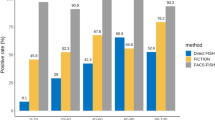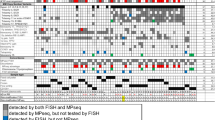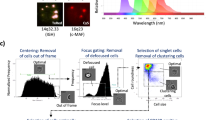Abstract
In this study we compared interphase fluorescence in situ hybridization (I-FISH) with reverse transcription polymerase chain reaction (RT-PCR) for the molecular analysis of hematopoietic colonies derived from patients with chronic myeloid leukemia (CML). Molecular analysis of individual colonies is often performed to monitor purging efficacy in CML. We harvested individual colony-forming unit granulocyte–macrophage (CFU-GM) colonies. One half was analyzed with I-FISH, for the presence of bcr-abl fusion gene. The other half was analyzed with RT-PCR for the presence of the bcr-abl mRNA. We wanted to address the following questions: (1) is the bcr-abl gene always expressed in CFU-GM colonies and (2) which technique has to be preferred to analyze individual CFU-GM colonies? In total, 133 colonies, derived from six CML patients, could be analyzed both with I-FISH and RT-PCR. We found a positive correlation in 89% of the cases: 118 colonies showed the same results with both techniques. However, 15 of the 106 I-FISH-positive colonies were negative in the RT-PCR. Serial analysis of the cDNA derived from 22 colonies showed in each round of amplification 21–29% RT-PCR-negative but I-FISH-positive colonies. However, all I-FISH-positive colonies showed at least one positive RT-PCR, either in the first, second or third round of amplification. These results indicate that the bcr-abl gene is probably always transcriptionally active in CFU-GM colonies. Reliable analysis with RT-PCR is possible but likely to generate false negative results. We conclude that: (1) I-FISH offers a reliable alternative to RT-PCR for analyzing individual hematopoietic colonies and (2) results obtained with RT-PCR should only be interpreted with caution.
This is a preview of subscription content, access via your institution
Access options
Subscribe to this journal
Receive 12 print issues and online access
$259.00 per year
only $21.58 per issue
Buy this article
- Purchase on Springer Link
- Instant access to full article PDF
Prices may be subject to local taxes which are calculated during checkout
Similar content being viewed by others
Author information
Authors and Affiliations
Rights and permissions
About this article
Cite this article
Thijsen, S., Schuurhuis, G., van Oostveen, J. et al. Molecular analysis of hematopoietic colonies derived from chronic myeloid leukemia patients: interphase fluorescence in situ hybridization compared with RT-PCR. Leukemia 11, 301–305 (1997). https://doi.org/10.1038/sj.leu.2400563
Received:
Accepted:
Issue Date:
DOI: https://doi.org/10.1038/sj.leu.2400563
Keywords
This article is cited by
-
Rapid detection of BCR-ABL fusion genes using a novel combined LUX primer, in-cell RT-PCR and flow cytometric method
Annals of Hematology (2008)
-
Biological effects of stroma-derived factor-1α on normal and CML CD34+ haemopoietic cells
Leukemia (2000)
-
Effects of bryostatin-1 on chronic myeloid leukaemia-derived haematopoietic progenitors
British Journal of Cancer (1999)



